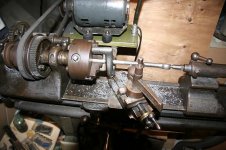Mike,
Are you confusing me with GTfour? I do have a bench top mounted metal lathe by WF Barnes, yes stubby legs and all. Based on input from Joe, I have a 4 1/2. I dont want to post pics in this thread, since it is GTfour looking for help with what maybe a No5. I dont want to distract from that. Pics of other No5 might be helpful.
I dont know, have we established what size gtfour has? I was just assuming 5.
I should clarify, my 'spare' gears, and other spare parts, have nothing to do with my Barnes any more or less than any other builder that has passed my way over the years. I just have a lot of parts, generically speaking - parts, stuff.
I would not go out of my way to acquire a foot power machine, it has happened a few times. Currently have a Shepard for example. None of these foot power metal working machines make any sense to me, cute as they maybe, they are not my cup-o-tea.
I know what you mean about interesting stuff coming with old machines, my Barnes had some 1870's, 1880's patented tooling, tailstock turret, etc.
If your No5, has some Boston gears, not 14 pitch, that might be a good guide for us to get gtfour setup. He does not need to do threading just looking to get some practical slow feeds rates. Can you suggest tooth/pitch combos that might get there, using boston gears?
Edit: I just looked, there is a thread chart on my head stock, it even says 4 1/2, FWIW. I guess, I would have to do more homework to make a definite stmt, that is was driven from overhead vs under. You are saying, all Barnes lathes were foot power, no exception? I dont see the need for those stubby short legs if it was driven from below?



